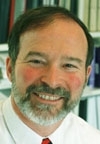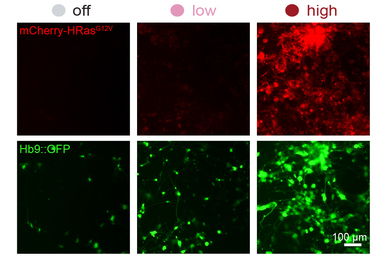President Charles Vest announced Tuesday the appointment of Robert P. Redwine, director of the Laboratory for Nuclear Science, 20-year faculty member and former undergraduate officer for physics, as dean of undergraduate education.
Dr. Vest said, "It is a privilege to announce the appointment of Professor Robert P. Redwine as dean of undergraduate education, effective in July. Bob has been a very effective director of the Laboratory for Nuclear Science, and now has expressed great enthusiasm for turning his energies and attention to the quality of our undergraduates' academic experience. He is a distinguished scientist and administrator whose open, interactive style is ideal for this deanship. He will be a highly effective voice on behalf of undergraduates on the Academic Council.
"I commend Chancellor Larry Bacow and the search advisory committee, chaired by Professor Graham Walker, for bringing such a strong, visionary and effective faculty member to this important position," Dr. Vest said.
Chancellor Bacow said, "Bob Redwine will make a fabulous dean. Prior to assuming the directorship of the Laboratory for Nuclear Science, he taught 8.01 [Physics 1] and played a leadership role in physics undergraduate education. A distinguished scientist and a wonderful educator, he will be a powerful and articulate voice for undergraduate education at MIT."
Both the dean for undergraduate education and the dean for student life will report to the chancellor under a new structure announced January 26.
Elizabeth Sharp, a junior in biology and a member of the eight-person chancellor's advisory committee on the search, said, "Right away, I was impressed with how approachable Bob is... It was obvious that his decisions are well thought out and I'm sure he will be very interested in student opinions regarding important issues." She added that Professor Redwine "shows a genuine desire to reach out to all the communities of MIT. I'm sure he will be a wonderful dean who will truly listen to and take into consideration the concerns of students."
Peter Shulman, the incoming president of the Undergraduate Association, a junior in mathematics and a member of the search advisory committee, said, "I am thrilled... [Professor Redwine's] ability to work with people, especially students, stands out and will no doubt be a great asset to us over the next several years. This is a very exciting time to be at MIT, and I'm looking forward to the opportunity to work closely with Bob in his new role as dean and to help continue the trend of improving undergraduate education."
"The search committee considers Bob Redwine to be a superb candidate for Dean of Undergraduate Education," said Professor Walker, head of the committee. "Before becoming head of LNS, Bob was intimately involved with teaching 8.01 and, in fact, helped introduce a new version of it. While head of LNS, he was highly regarded on Science Council and elsewhere for his thoughtful views on undergraduate education...
"We feel that Bob has the necessary personal skills to listen to all members of the Institute family -- students, faculty, staff and administration -- in a thoughtful and caring way, and has the vision and leadership ability to help us all work together in making undergraduate education at MIT the most wonderful and rewarding experience possible," Professor Walker said.
"It's very exciting," Dr. Redwine said Monday about his new job. "For me, one of the main attractions of being a faculty member at MIT is the extraordinarily talented group of students who come to MIT. The opportunity to direct the Laboratory for Nuclear Science was a wonderful one, and the laboratory continues to be a world-leading center for high-energy and nuclear physics.
"The chance to play an important role in shaping the undergraduate educational experience at a leading and unique institution such as MIT simply proved irresistible. I appreciate very much the confidence being placed in me by President Vest and Chancellor Bacow.
"I am especially honored to be able to follow Dean Rosalind Williams in this position. Dean Williams came into the position as one of the most respected members of the faculty and is ending her tenure with this respect enhanced. She has done an extraordinary job the past several years under some of the most difficult circumstances any of us could imagine. She has my utmost gratitude and that of the entire MIT community.
"I look forward to working with many groups at MIT, especially the students, to continue MIT's tradition of creative, leading efforts in undergraduate education. We have the opportunity, with new resources in this area, to shape future science and engineering education at MIT and indeed more broadly. I am sure the next several years will be truly exciting ones," Professor Redwine said.
"The future of the dean's office is in good hands," Dean Williams said. "Most recently, Bob has served as the gifted and effective administrator of LNS. He has also served as the undergraduate officer for physics, where he took a lead role in promoting hands-on learning and in efforts to recruit outstanding science students to the Institute. This is an ideal combination of experience to bring to the role of dean for undergraduate education. Even more important, Bob brings human qualities of warmth and openness that students will appreciate and enjoy."
Following completion of his BA (1969) at Cornell and PhD (1973) at Northwestern, Professor Redwine held positions at the University of Berne in Switzerland and at Los Alamos National Laboratory. He has been a member of the MIT faculty since 1979.
Professor Redwine has been involved in a variety of important experiments in intermediate energy physics, spanning weak, electromagnetic and strong interaction physics.
He and his group are currently involved in two major projects. The HERMES experiment at the DESY (Deutsches Elektronen-Synchrotron) laboratory in Hamburg, Germany, is studying the spin structure of protons and neutrons. The other major project is the BLAST (Bates Large Acceptance Spectrometer Toroid) detector for internal target studies for nucleon and few-nucleon systems, conducted at the Bates Linear Accelerator in Middleton, MA, a national Department of Energy facility operated by the MIT Laboratory for Nuclear Science.
He has served on many national and international physics advisory committees and is a fellow of the American Physical Society and the American Association for the Advancement of Science. He is married to Professor Jacqueline N. Hewitt of the Department of Physics; they live in Winchester with their two sons.
A version of this article appeared in MIT Tech Talk on May 10, 2000.






